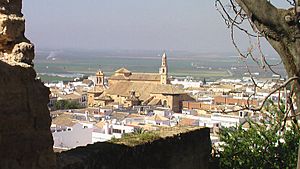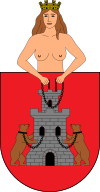Osuna facts for kids
Quick facts for kids
Osuna
|
|||
|---|---|---|---|

View of Osuna
|
|||
|
|||
| Country | |||
| Autonomous community | Andalusia | ||
| Province | Seville | ||
| Area | |||
| • Total | 592.49 km2 (228.76 sq mi) | ||
| Elevation | 328 m (1,076 ft) | ||
| Population
(2018)
|
|||
| • Total | 17,622 | ||
| • Density | 29.7423/km2 (77.0321/sq mi) | ||
| Demonym(s) | Ursaonense | ||
| Time zone | UTC+1 (CET) | ||
| • Summer (DST) | UTC+2 (CEST) | ||
| Postal code |
41640
|
||
Osuna is a lovely town and municipality (which is like a local government area) in southern Spain. It's located in the province of Seville, within the region called Andalusia. As of 2009, about 17,800 people lived there. Osuna is also home to the Andalusian Social Economy School.
The town is built on a hill. From there, you can see a flat, fertile plain. This plain gets its water from the Salado River. The Salado River eventually flows into the bigger Guadalquivir River.
Contents
History of Osuna
Osuna has a very long and interesting history. Many important events happened here.
Ancient Battles and Roman Times
One of the most famous battles in ancient history might have happened near Osuna. This was the battle of Munda. It was the last battle won by the famous Roman leader Julius Caesar himself. This battle probably took place between Osuna and another town called Écija, close to La Lantejuela.
From Moorish Rule to Spanish Control
Osuna was once part of a region ruled by the Almohads. These were a group of people from North Africa. In 1239, during the Reconquest of al-Andalus (when Christian kingdoms took back land in Spain), Osuna was captured.
In 1264, King Alphonso X gave Osuna to the Order of Calatrava. This was a powerful group of knight-monks. Later, in 1445, a person named Don Pedro Girón took control of the town for himself.
The Dukes of Osuna
One of Don Pedro Girón's family members was Don Pedro Téllez. In 1562, King Philip II gave him the special title of "Duke of Osuna." This made him the first Duke of Osuna.
Famous People from Osuna
A famous person connected to Osuna is Juan de Ayala. He was a commander who made history. He led the first European ship to sail into the San Francisco Bay in California.
Important Sights in Osuna
Osuna has several old and beautiful buildings that are worth seeing.
The Collegiate Church
At the very top of the hill in Osuna, you'll find the collegiate church. It was built starting in 1534. Inside, it has many interesting Spanish and early German paintings. However, these paintings and the sculptures on the church's entrance were damaged. This happened when the French army, led by Marshal Soult, occupied the town.
The church has special arched ceilings called vaults. These vaults are supported by arches built in a Moorish style. The church also holds the tombs of the Girón family. The church itself was founded by Don Juan Téllez.
The Old University
Osuna also had its own university. It was founded by Don Juan Téllez in 1549. However, this university was closed down in 1820.
See also
 In Spanish: Osuna para niños
In Spanish: Osuna para niños




